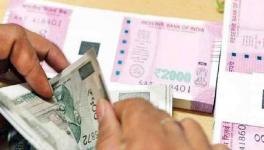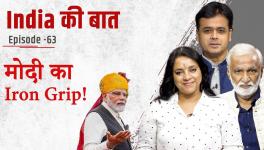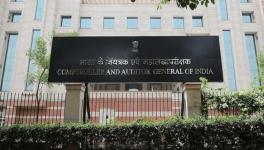The Great Indian Gold Heist
Image for representational use only; Image Courtesy : Public Radio International
The 80:20 gold import-export scheme that began in July 2013 when the UPA government was in power and continued till November 2014, six months into the tenure of the Modi government, has been sharply criticised by the CAG. The scandal is much bigger than what had been presumed. The contentious scheme was availed of by well-known private firms, government companies and banks – including corporate entities led by India’s richest man, diamond merchants who are absconding in tax havens and individuals associated with the son of the president of the country’s ruling party. Despite the demand made by a BJP MP, detailed investigations have not taken place. Is this because certain prominent persons are involved?
It was a gold import-export scheme that began when the Congress-led United Progressive Alliance (UPA) government was in power and continued six months into the tenure of the Narendra Modi regime. That the scheme was a scam has been widely acknowledged by, among others, the Comptroller and Auditor General of India, the constitutional authority responsible for overseeing the country’s public finances. Representatives of the Bharatiya Janata Party (BJP) and the Indian National Congress have publicly blamed one another for the scandal. A parliamentary panel is examining this unprecedented heist. The companies that availed of the highly-questionable “80:20” trading scheme in the precious metal include big names among government-owned corporations and banks as well as companies in the private sector.
In this article, we reveal for the first time the truly mind-boggling dimension of this scandal involving transactions aggregating ₹2,65,000 crore, or the equivalent of $35 billion, which makes the scam considerably bigger than what was earlier presumed.
We also disclose the full list of entities that undertook imports and exports of gold under the controversial scheme, which includes India’s biggest privately-owned company, Reliance Industries Limited, headed by the country’s richest man Mukesh Ambani; Gitanjali Gems led by Mehul Choksi, who recently surrendered his Indian passport in Antigua; and Winsome Diamonds controlled by Jatin Mehta (who is related by marriage to Gautam Adani’s older brother Vinod Adani) – Choksi and Mehta are both fugitives who have fled the country.
Other private sector firms in the list are Jindal Dyechem (a “four star” export house headed by SK Jindal), Zaveri & Co, Edelweiss Commodities, Rajesh Exports (whose promoters control the world’s biggest gold refineries), MD Overseas and Kanak Exports Ltd (a company controlled and owned by family members of the promoters of MD Overseas – the Supreme Court had passed strictures against Kanak Exports for mis-invoicing in a judgement delivered in October 2015).
Also in this list are Kundan Rice Mills and Khandwala Enterprises (promoted by the members of the Khandwala family who have links with Jay Amit Shah, son of Amit Shah, MP, BJP president and among the most powerful persons in India at present).
The list of entities includes major public and private sector banks – Punjab National Bank, HDFC Bank, Union Bank of India, Bank of India, Axis Bank, Corporation Bank and IndusInd Bank – as well as government-owned companies like the Metals & Minerals Trading Corporation (MMTC), the State Trading Corporation (STC) and the Handicrafts & Handlooms Exports Corporation (HHEC).
In this article, we point towards several financial and legal issues that should ideally have come up at the time the 80:20 gold import-export scheme was conceptualised and, which prima facie suggest that government officials and politicians who operationalised and directed the notification of the scheme may have been acting on considerations other than the need for good governance and prudent fiscal management. We argue in this article that all imports of gold under the scheme were potentially illegal under different provisions of various Indian laws.
Since the much-discussed departures from India of diamantaires Nirav Modi and Mehul Choksi became known in February 2018, a sub-committee of the Public Accounts Committee (PAC) of Parliament has been seized of the murky affairs of particular companies in the gems and jewellery sector, which is one of India’s significant foreign exchange earning industries. In March 2018, it was reported that the sub-committee of the PAC was focussing on the “80:20 scheme” of gold imports.
Spokespersons of the BJP-led National Democratic Alliance (NDA) government, including Union Law Minister Ravi Shankar Prasad and BJP member of Parliament Nishikant Dubey have alleged that the scheme was designed to help jewellers such as Nirav Modi and his uncle Choksi and that it was a scam involving an aggregate amount up to ₹1,00,000 crore. Their views were apparently based on a report prepared by the Comptroller and Auditor General (CAG) of India in 2016.
Thereafter, media reports about the scandal have resurfaced from time to time. In March 2018, it was reported that the scheme was pushed through by former Union Finance Minister P Chidambaram in the UPA government despite the strident opposition of a section within the Ministry he was then heading, namely, the Directorate of Revenue Intelligence (DRI), the investigative wing of India’s customs organisation. Shortly afterwards, it was reported that the PAC sub-committee had sought an investigation by the Central Bureau of Investigation (CBI) and the Enforcement Directorate (ED) into the activities of 35 jewellers.
A draft report prepared by the sub-committee of the PAC in April apparently zeroed in on a particular change made to the scheme by the UPA government on May 21, 2014 – a few days after the Modi-led NDA had been declared victor in the 2014 Lok Sabha elections on May 16, but before it formally assumed office five days later on May 26. The change permitted large exporters to avail the scheme. The changes to the 80:20 gold import-export scheme have allegedly facilitated “round-tripping” of black money through manipulation of invoices. This change, it has been argued, contributed to the abuse of the scheme that had been initiated to increase foreign exchange earnings from exports of gold and jewellery at a time when the external value of the Indian currency was going down and the government in New Delhi was faced with a sudden rise in the country’s current account deficit (CAD), which is the difference between the total values of imports and exports.
What Was the 80:20 Gold Import-Export Scheme?
In 2013, as the exchange rate of the rupee vis-à-vis the US dollar slid, the UPA government decided to curtail gold imports which account for a large segment of India’s payments in foreign exchange. A view was expressed that reducing gold imports would lead to savings of hard currencies and thus lead to a stabilisation of the external value of the rupee. A meeting was convened in early-2013 by the Ministry of Industry and Commerce which included representatives of banks, while importing and exporting firms were represented by the Gem and Jewellery Export Promotion Council. During a press conference held on June 13, 2013, the then Finance Minister Chidambaram said: “If I have one wish which people of India can fulfil, that is: do not buy gold,” adding: “If we can have this (no buying gold) for six months or one year, it will dramatically change the CAD situation.”
He stated this after a number of measures had already been taken to curb gold imports. On May 13, 2013, the Reserve Bank of India (RBI) had issued a notification restricting imports of gold by banks. In another notification issued on June 4, 2013, it extended the same restrictions to agencies nominated by the Directorate General of Foreign Trade (DGFT) in the Ministry of Commerce and Industry – that is, to private importers of the yellow metal. These restrictions allowed gold imports to take place only on a “consignment basis,” thereby eliminating the possibility of using bank loans or other forms of bank credit to support these imports. Further strengthening these restrictions, another notification on June 27, 2013 was issued by the RBI stating that “banks are required to ensure that credit in any form or name is not enabled for import of any form of gold.”
These steps were consistent with the government’s policy objective at the time to reduce gold imports. It had already hiked the import duty on gold twice that year, from 2% to 5% in January, and from 5% to 8% in June. The Finance Ministry would hike the customs duty on gold once again from 8% to 10% later in August. The import duty on raw gold and gold ore had also been increased during the year.
In its monetary policy for 2013-14, the RBI announced that it would “restrict the import of gold on consignment basis by banks only to meet the genuine needs of exporters of gold jewellery, with a view to reducing the demand for gold for domestic use.” The RBI’s “Working Group on Gold,” which submitted its report in February 2013, had further stated that “imposing limits on the quantum and value of gold a bank could import will be [an] option under extreme circumstances of external sector vulnerability. Once the CAD situation improves, the restrictions imposed on banks to deal with gold transactions can be reviewed.”
These developments led to a crunch in the availability of gold across the country as a result of which, jewellers raised strong objections. On July 6, 2013, the Times of India reported “a volley of protests” at a meeting held the week earlier that had been convened by the then Union Minister for Commerce and Industry Anand Sharma with representatives of gold traders and jewellers. A day earlier, the Revenue Secretary and the Economic Affairs Secretary in the Finance Ministry had met representatives of banks and gold importing and exporting firms represented by the Gem and Jewellery Export Promotion Council. Reporting on the meeting, Times of India quoted Pankaj Parekh, the Council’s then vice-chairman, saying: “We have sought some relief from the government, as exports have started becoming uncompetitive.”
A reliable source told us that the suggestion for the 80:20 scheme first came from Parekh who is a leading light in the jewellery traders’ lobby. He apparently suggested that every lot of gold that was imported should only be permitted to enter the country on the basis of “proof of export” of at least 20% of the previously imported lot as a step towards reducing the CAD. His suggestion was accepted and this resulted in the rolling out of the scheme on July 22, 2013 through a notification issued by the RBI. The 80:20 scheme continued till November 28, 2014, when it was scrapped.
Incidentally, Pankaj Parekh is the uncle of Nilesh Parekh, promoter of the Kolkata-based Shree Ganesh Jewellery House Limited, who was arrested in June 2018 by DRI for transacting 1,700 kilogrammes of primary gold in an allegedly illegal manner and “not realising” remittances on account of exports of gems and jewellery worth ₹7,500 crore through several firms located in Manikanchan Special Economic Zone in the city. He had been arrested in 2017 as well by the Central Bureau of Investigation (CBI) for allegedly defrauding a consortium of banks led by the State Bank of India for not repaying loans worth ₹2,672 crore. His firms are also being investigated by the ED.
Under the 80:20 scheme, any entity that imported gold would be able to do so only under controlled circumstances. An entity would first have to move one-fifth of the yellow metal it imported into the export pipeline. Thereafter, only upon completing the export and showing appropriate invoices, would the entity concerned be given access to the remaining 80% of the gold for use in the domestic market and subsequently, be granted clearance to import the next consignment. Additionally, the scheme, as notified, insisted that no credit could be extended to such agencies when receiving the balance 80% of imported gold and this could only be released after full payment was made upfront.
Publicly-listed gold jewellery companies immediately saw their stock prices rally in response to the notification of the scheme. This was because while restricting imports, the 80:20 notification also withdrew credit restrictions scrapping the earlier conditions imposed by the RBI that saw imports restricted on a consignment basis and the requirement of 100% cash backing for issuance of letters of credit by banks. The credit lines favoured for production of gold jewellery became available once again
Was the Scheme Really Needed?
Available data on gold exports and imports suggest that the motivation for the scheme was on rather dubious grounds. Official statistics show that the value of India’s gold imports in 2011-12 and 2012-13 were approximately $54 billion and $49 billion, respectively, while exports of gold jewellery in these two fiscal years earned the country $10 billion and $13 billion, respectively. Revenues from exports of gold coins rose from $400 million to $4 billion in these two years. In short, approximately a quarter of the outflows measured in US dollars used for importing gold was recovered from exports in these two years put together.
The view that the 80:20 scheme was not required, is strengthened in the CAG report. It points out that India earned less foreign exchange from gold exports than it lost in the form of “revenue foregone” to the exporting companies – this was on account of the exemptions on payment of customs duty and other taxes that were granted to the trading entities. To quote directly from the CAG report:
“…when Net Foreign Exchange realised is less than the duty foregone, it has a direct impact on the fiscal management. Very low value addition did not help in generating economic activity in the sector and induced inflated trade data, opening up the window for round tripping.”
It is not as though the government did not have adequate advance warning of this possibility before the scheme was notified. Writing for the Financial Express, journalist Devangi Gandhi described the “belief” that the move “may lead to false reporting of exports [or] round-tripping.” “While these changes make exporters the biggest beneficiaries, they may also lead to a rise in delusive reporting of exports by ‘pretend’ value additions like packaging changes,” the publication stated, quoting a “sector expert.”
The other argument on the “need” for the scheme can be found in the actions of the RBI on imports of gold prior to its July 22, 2013 notification. The various notifications issued earlier should have done the job of checking gold imports and thereby conserving foreign exchange. In fact, they did, virtually overnight. Average imports of gold fell – from a monthly average of 110 tonnes between January and May 2013 to 50 tonnes in June and July 2013. Why then was the 80:20 scheme needed at all and why was it notified by the country’s central bank?
Why Did the RBI Notify the Scheme?
In February 2013, a working group of the RBI constituted to study issues relating to gold imports and gold loans released its report, alluded to earlier in this article. In this report, it was acknowledged that the high volumes of gold imported into India represented a macro-economic risk on account of the pressure exerted on the country’s CAD and by depleting foreign exchange reserves.
While the group admitted that the high demand for gold in India was a consequence of socio-cultural factors and that it may not be possible to temper gold demand beyond a point, a number of measures were considered both with regard to the supply of and demand for gold. The idea that gold imports could be temporarily restricted at a time of fiscal pressure finds its genesis in this report. It was based on this report that the RBI’s sequence of measures curbing gold imports, before and after the 80:20 scheme was notified, was formulated. Consider the following direct quote from the report:
“Unless gold imports are converted into re-exports or volume of gold import does not moderate, increasing quantum of gold imports not only stresses India’s CAD but would also be a drag on India’s foreign exchange reserves.”
Our sources in the Finance Ministry, however, pointed out that a key issue of contention relating to the 80:20 scheme lay in the fact that it was born out of an RBI notification on a subject that is supposed to be outside its remit. Under India’s regulatory structure, any restrictions on what was essentially a trading scheme should have been the responsibility – and under the domain – of the DGFT, which is an agency of the Union Ministry of Commerce and Industry. The previous RBI notifications, namely, those issued on May and June 2013, pertained to payments and credit relating to gold imports and were primarily restrictions on financial flows, thus coming appropriately within the ambit of the RBI’s functions.
By notifying the 80:20 scheme, however, the RBI arguably overstepped its remit by seeking to directly regulate the import of a commodity, an activity that is supposed to be the DGFT’s responsibility. The Foreign Trade (Development and Regulation) Act, 1992, is the basis of making this claim. The DGFT is the regulatory body responsible for implementing the Act which, in its introduction, states that it is “an Act to provide for the development and regulation of foreign trade by facilitating imports into, and augmenting exports from India...”
Section 2.7 of the country’s Foreign Trade Policy (FTP) 2009-14, stated:
“Any goods, export or import of which is restricted under ITC (HS) [or the Indian Trade Clarification based on Harmonised System of Coding] may be exported or imported only in accordance with an authorisation or in terms of a public notice issued in this regard.”
Trade in gold, which comes under HS Codes 71081200 and 71081300, was not a “restricted” commodity but its imports came under the category of “free entry” subject to such imports adhering to RBI regulations. It was only in the FTP 2015-20 that it was specified that the DGFT could restrict imports of gold and silver as per Provision 2.07 of the general provisions relating to imports and exports.
The RBI Act limits its responsibility to managing the country’s foreign exchange reserves. Hence, in this case, if the import restrictions were motivated by the intention of conserving India’s foreign exchange reserves, the communication channels should have been different – namely, from the RBI to the DGFT and/or from the Ministry of Finance to the Ministry of Commerce and Industry. After the RBI and/or the Finance Ministry suggested the measures, these should have been duly notified by the DGFT after the FTP 2009-14 was amended, as it was by inserting Provision 2.07 in the FTP 2015-20.
Why was the UPA government in a hurry to amend the rules? At that time, the RBI Governor was Raghuram Rajan. It is unclear why the RBI under his management agreed to notify these import restrictions. While the RBI is an autonomous body, two of its directors are appointed by the Finance Ministry. If it has been recorded that a direction was sent by the Finance Ministry to the RBI suggesting the notification of the scheme, that could constitute a serious breach of the RBI’s autonomy.
Were Government Agencies Equipped to Monitor the 80:20 Scheme?
Under the RBI’s notification, the monitoring of the scheme was to be done by the Central Board of Excise and Customs (now designated the Central Board of Indirect Taxes). But the board was clearly unprepared for the exercise. This what the CAG report concluded:
“Since bulk of the imports and exports transaction(s) of the country is handled by the PCCCC [Precious Cargo Customs Clearance Centre]… and (by) not capturing the data in (the) EDI [Electronic Data Interchange] system (it) resulted in escaping the scrutiny of the Risk Management System (RMS) and Post Compliance Audit (PCA) introduced by the Department (of Revenue) for examination of the high risk cargo. In our opinion, the delay in integrating export transactions with (the) EDI has increased the risk of tax evasion and undervaluation/overvaluation…”
The CAG report added:
“…imports made with corresponding export obligations under various export incentive schemes of (the) government remain largely unmonitored as the export data are not captured by the system. Audit also observed that all the transaction relating to import of Gold Dore Bars are done manually since there is no facility to generate Bills of Entry and debit respective licenses in the EDI system (and) therefore the control mechanism envisaged through RMS, PCA, Special Valuation Branch (SVB), DRI and other authorities (is)… not being exercised.”
Gold dore is a semi-pure gold and silver alloy. It is important to understand in lay language that if it is claimed that dore has gold content of 80%, a customs official will have to accept this claim at face value – as the “assay certificate” that is furnished is given on the basis of “mutual trust” – even if the gold content is actually higher at, say, 94%. (Assaying refers to the “testing or examination of a metal or an ore to ascertain its ingredients or quality.”)
A press release accompanying the CAG report was even more damning in its remarks. It stated:
“Gaps in the valuation database management and Customs electronic data application allowed gradual increase in trade mis-invoicing over the period leading to foreign exchange/capital outflow.”
How Did the Scheme Affect the Bullion Trade?
In its press release, the CAG stated that “the change in gold price, import regulation, export promotion schemes did not have a material impact on the gold trade. The gems and jewellery trade related financial outflow continued unabated.”
The CAG report explained:
“…there was a surge in import of gold jewellery from Asian countries during the year 2013-14 and 2014-15 when the 80:20 scheme was in operation, since import of gold bar(s) was restricted for normal importers during the … period. On an average 64 per cent of imported gold jewellery (came) from Switzerland, (the) UAE (United Arab Emirates) and Hong Kong out of … 120-odd … countries (from where the gold was sourced). However, the importing countries were not being exported to, except in case of (the) UAE and Hong Kong. Similarly, 63 per cent exports of jewellery were to (the) UAE and Hong Kong. The country (wise) trade analysis indicates repeated transactions ... cases of related party transactions, inverted duty structure and re-export. Evidently, trade with (the) UAE involving re-export did not create major economic activity while inflating the total value of the trade (emphasis added).”
How did the scheme facilitate round-tripping of gold and money laundering? Under normal circumstances, plain “casted” jewellery takes about 10 days to produce while medallions or coins can be made ready for export in three days. However, when faced with the condition that the supply of imported gold for domestic sales would only be cleared against proof of exports, traders adopted a different strategy. Imported bullion were converted into 24 carat long chains, bangles and coins, within 24 hours and promptly exported.
During this period, the DRI confiscated an export consignment from Mumbai’s Zaveri Bazaar (where many gold and jewellery trading firms are located) which included jewellery coated with 24 carat gold up to a depth of 100 microns beneath which was copper! Our sources in the Finance Ministry, speaking on condition of anonymity, did not disclose the name of the firm allegedly involved in the racket but merely stated that it was “connected” to a “four star” export house.
These chains, bangles and coins were exported after showing that the minimum value addition required had been achieved by manipulating invoices, our sources alleged. The exported goods were purportedly molten and recast into bars in the UAE and returned into the supply chain. While this allegation has not been substantiated in either the CAG report or the draft report of the PAC sub-committee, there is circumstantial evidence that points to this possibility given the unusually short turnover periods. Our sources claimed that the largest consignments of exports were made to the UAE from where the goods would move to Abu Dhabi airport and then to a refiner in Zurich. The Zurich refiner would melt the chains, bangles and coins and sell the gold back in the form of bars to an Indian nominated agency.
The short lead times have been detailed in the CAG report, which flagged the suspicions of auditors as to whether genuine value addition had taken place before the jewellery was exported. The CAG further pointed out how, in certain instances, exports took place parallel to the release of the remaining imported consignments from the customs holding area, with the concerned concerned – banks or private companies – receiving the remitted amount for their exports on the day after the date of the invoice.
To explain how the structure of the scheme enabled money laundering and round tripping of funds, consider the following example.
Let us assume a trader has received ₹1,00,000 worth of gold for export. Under the minimum value addition requirements, he would have to export medallions worth ₹1,01,500 or jewellery worth ₹1,03,500 – that is, a value addition of ₹1,500 or ₹3,500, respectively. However, in the scenario outlined above, the actual value addition – that is the cost of manufacture and export would only come up to ₹350. Thus a mechanism was created to route extra funds into India through such exports.
The suggestion that there was money laundering and round tripping of black money held by the Indian entity assumes that in connivance with related parties abroad, the Indian entity can route its own money back to itself – or round-trip the money – through foreign jurisdictions after having “laundered” black money into “white” export earnings. Black money “stashed” by Indians in foreign banks, particularly Swiss banks, could easily find a “legitimate” route back into India through this method. In this particular example, after spending ₹350, the entity could get ₹3,150 back to the country.
The Italian Connection
Consider the following facts and figures given in the table below. The quantum of gold imported into India increased dramatically after two specific changes were made to the rules of the scheme by the RBI.

Source:Finance Ministry
There are two significant notifications of amendments to the 80:20 scheme that explain this pattern of gold imports. The first was the notification of December 31, 2013 which related to refiners. Refiners of gold, whose imports were regulated under the original scheme, were exempt from these regulations after the notification of December 31, 2013. The upshot was that a number of new gold refineries were opened in India following the notification, which accounted for the rise in imports in that period. This accounts for the first increase in import levels – from 90 tonnes in approximately five and a half months to 202 tonnes in the following four and a half months. The opening of these gold refineries came as a big boon to a clutch of companies based in Italy that supply equipment. Our source told us that “one of the largest gold refiners imported 70% of its machinery from Italian firms.”
Why did the changes in the scheme suit refiners of gold? This was simply on account of the fact that at that particular time there was a shortage of gold in the country because of the clampdown on imports. Gold was selling at a premium of more than $100 an ounce. This was also reflected in the pattern of imports of gold dore. The refiners that had the license to import dore were also regulated by the RBI’s notification. These refiners imported 127 tonnes of dore after the December 31 notification. The loophole in the scheme was that while trading in gold is subject to RBI regulations, this was not so in the case of gold dore – and dore could be converted into refined gold by incurring negligible additional expenditure that is barely 0.2% of the total cost of the yellow metal.
The second significant notification was the one issued on May 21, 2014 which extended the scheme to “star” and “premier” trading houses. Trading houses were classified as “star” and “premier” if their exports were worth above ₹2,500 crore and ₹7,500 crore, respectively. From the start of the 80:20 scheme, till this notification, star and premier trading houses were only permitted to import gold for the purpose of exports. The May 21, 2014 notification permitted them to participate in the domestic markets as well. Accordingly, as the figures show, there was a jump in gold imports by major players who are named in the table below.

Source:Finance Ministry
* “Before 21 May” signifies 22 July 2013 to 21 May 2014 and “After 21 May” signifies 22 May 2014 to 22 November 2014
** “Before 31 Dec” signifies 22 July 2013 to 31 December 2013 and “After 1 Jan” signifies 01 January 2014 to 22 November 2014
Blank spaces indicate that exports were nil
The pattern is evident. There was a discernible jump in the volumes of gold imported after the May 21, 2014 notification in the case of top trading houses and in the imports of gold dore after January 1, 2014 in the case of refiners. Most of the companies listed above were not exporters themselves but utilised the services of over 250 smaller firms that were active between May and November 2014 while the 80:20 scheme was in operation. Thereafter, these firms became dormant, our sources claimed on the basis of information available with the Registrar of Companies. According to him, this indicated that “these companies were deliberately created for the purpose of misusing the 80:20 scheme.”
The total value of the gold exported between May and November 2014 was roughly $3 billion. Against this figure, the amount of black money that may have been laundered and brought back to the country could be more than three times higher and close to $10 billion!
Consider the CAG’s remarks:
“Audit scrutiny of the records of selected PTHs/STHs (premier trading houses/star trading houses) showed that PTHs/STHs mostly exported plain gold jewellery, bangles or medallions with negligible or no value addition. Even cases of export of 24 carats gold jewellery were noticed. In many cases plain jewellery were exported within (the) same day or within 1 to 3 days of receipt of gold. Exports were also made to related parties. Some of the remittances were being received the very next day. Possibility of exporting products without even nominal value addition as plain jewellery by these agencies could not be ruled out. These importers were importing high quantities of gold by repeated exports at very short intervals, so as to maximise their domestic sale entitlement against (the) 80 per cent component of (the 80:20) scheme.”
It is worth questioning as to why these companies were given import/export licenses for trading in gold by the DGFT.
How Big Is the Scam?
It should be noted that the private companies mentioned were not just importing gold themselves but also utilising gold imported by banks and public sector undertakings that availed of the 80:20 scheme. It can be contended that the entire quantum of gold imported under the scheme was against illegal exports and thus liable for confiscation as “smuggled goods” under Section 111 of the Customs Act.
The following table lists all the entities that imported gold under the 80:20 scheme and the exact values of the gold imported.
| Name of importer | Total Assessable Value of Gold Imported (Rs.) |
|---|---|
| AJ GOLD & SILVER REFINERY | 4,885,847,514.280 |
| ASHAPURA REFINERY PRIVATE LIMITED | 66,997,733.540 |
| AXIS BANK LTD. | 116,094,495,480.270 |
| BANGALORE REFINERY (P) LTD | 65,545,895.320 |
| BANK OF INDIA | 34,232,677,528.590 |
| BANSAL IMPEX | 143,200,602.570 |
| CENTRAL BANK OF INDIA | 1,089,551,250.000 |
| CHEMMANUR GOLD REFINERY (P) LTD | 177,897,031.900 |
| CORPORATION BANK | 2,600,317,680.000 |
| DIAMOND FOREVER INTERNATIONAL | 10,665,032,974.640 |
| DIAMOND INDIA LTD | 22,015,397,080.000 |
| EDELWEISS METALS LIMITED. | 46,878,736.240 |
| EDELWEISS COMMODITIES SERVICES LTD | 99,024,852,051.030 |
| GGC GUJRAT GOLD CENTRE PVT. LTD. | 1,688,056,202.950 |
| GITANJALI GEMS LTD. | 1,346,671,800.000 |
| HDFC BANK LTD., | 29,564,510,595.000 |
| INDIAN OVERSEAS BANK | 7,849,842,490.000 |
| INDUSIND BANK LTD., | 88,213,671,020.890 |
| JALAN & CO, | 13,999,529.230 |
| JINDAL DYECHEM INDUSTRIES PVT LTD. | 9,450,628,900.000 |
| KANAK EXPORTS | 53,708,624,863.000 |
| KHANDWALA ENTERPRISE PVT. LTD. | 48,230,015,700.000 |
| KOTAK MAHINDRA BANK LIMITED | 41,770,740,998.610 |
| KUNDAN CARE PRODUCTS LTD., | 24,329,256,809.190 |
| KUNDAN RICE MILLS LTD. | 122,151,538,204.250 |
| M D OVERSEAS LTD. | 122,667,190,877.900 |
| MMTC LIMITED | 56,668,582,884.340 |
| MMTC PAMP INDIA PVT. LTD. | 189,737,860,828.110 |
| MULTI VISION | 66,530,500.390 |
| PEC LIMITED | 18,149,829,605.000 |
| PUNJAB NATIONAL BANK. | 22,431,442,000.000 |
| RAJESH EXPORTS LTD | 295,689,793,500.000 |
| RELIANCE INDUSTRIES LTD. | 2,239,384,500.000 |
| RELIANCE RETAIL LIMITED | 1,160,086,800.000 |
| RIDDI SIDDHI BULLIONS LTD. | 92,117,153,625.000 |
| SAI REFINERY, | 1,633,014,193.610 |
| SHREE GANESH JEWELLERY HOUSE (I) LIMITED, | 2,870,172,595.640 |
| SHREE SURYA REFINERY | 178,351,004.410 |
| SRI SAI VISHWAS POLYMERS | 83,688,935.470 |
| STATE BANK OF INDIA | 80,086,340,180.520 |
| SU-RAJ DIAMOND INDUSTRIES LTD. | 962,192,161.090 |
| SU-RAJ DIAMOND INDUSTRIES PRIVATE LIMITED | 742,882,500.000 |
| THE BANK OF NOVA SCOTIA | 301,254,439,377.130 |
| THE HANDICRAFTS & HANDLOOMS EXPORTS CORP.OF | 22,178,279,300.000 |
| THE STATE TRADING CORPORATION OF INDIA LTD. | 82,612,762,178.200 |
| UNION BANK OF INDIA | 63,375,946,100.930 |
| VECTOR INGOT PVT.LTD | 292,098,837.410 |
| YES BANK LTD. | 9,410,593,131.950 |
| ZAVERI & CO PVT. LTD. | 175,686,225,242.820 |
| Grand Total | 2,261,721,089,531.420 |
If all such imports took place against fraudulent exports, then the imports were also illegal implying that the scandal involved a mind-boggling ₹2.65 lakh crore or $35 billion.
What needs to be investigated is whether the officials of the banks and public sector corporations concerned knew that they were facilitating illegal exports. Did the banks know what they were doing?
The circumstantial evidence we have outlined in this article raises serious doubts about the scheme which was initiated by the UPA government. Questions have been raised as to whether the Finance Ministry under Chidambaram should have changed the scheme on May 21, 2014, bringing large trading houses under its ambit, when his government was a caretaker government since the results of the Lok Sabha elections were known at that time. It is also important to ask why the Modi government allowed the amended scheme to continue for six months despite the spike in gold imports being common knowledge.
Besides the Customs Act, the 80:20 gold trading scheme prima facie violated the Prevention of Money Laundering Act, the Prevention of Corruption Act and the Foreign Trade (Development and Regulation) Act and should be investigated by the ED, the DRI and the CBI. In fact, in a speech in Parliament in July 2018, BJP MP Nishikant Dubey sought to indict officials in the Finance Ministry for allowing this scheme to continue and called for a probe by the ED and the CBI.
Will the Modi government heed the advice of one of its own MPs a few months before the next general elections take place? Will such an investigation ever take place in view of the likely involvement of affluent and influential individuals?
Get the latest reports & analysis with people's perspective on Protests, movements & deep analytical videos, discussions of the current affairs in your Telegram app. Subscribe to NewsClick's Telegram channel & get Real-Time updates on stories, as they get published on our website.
























